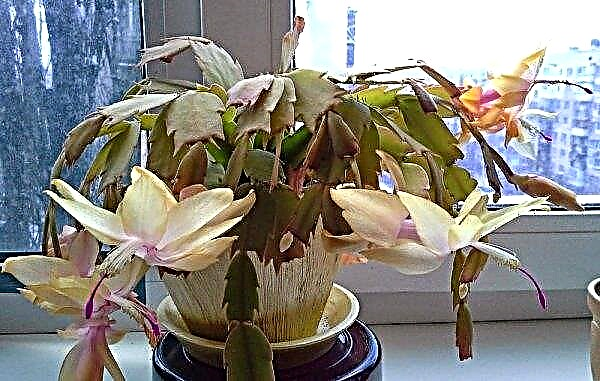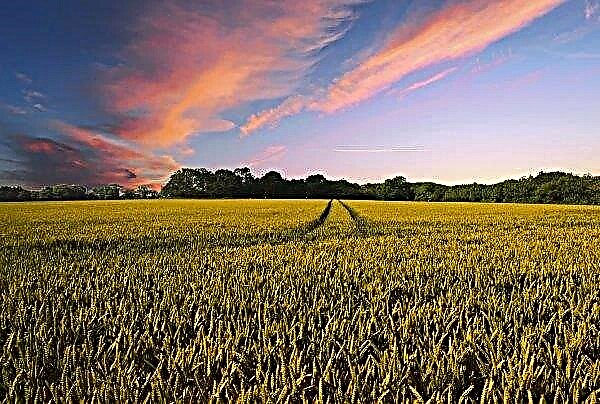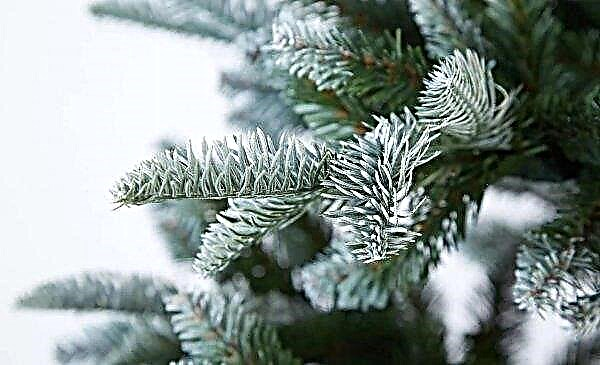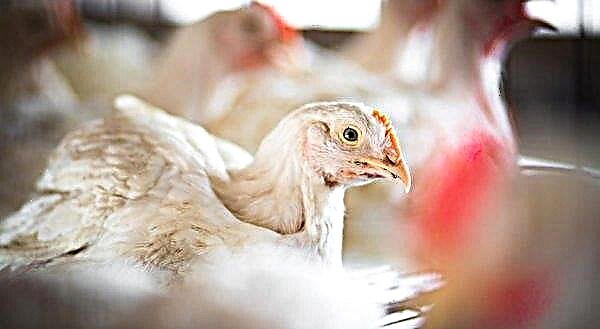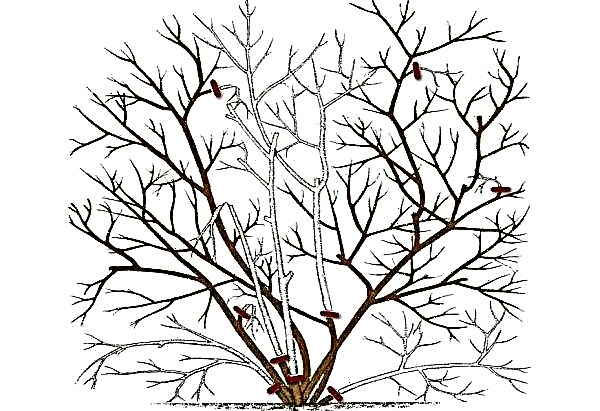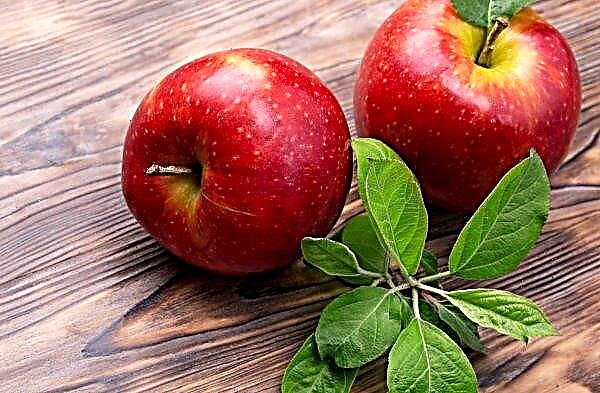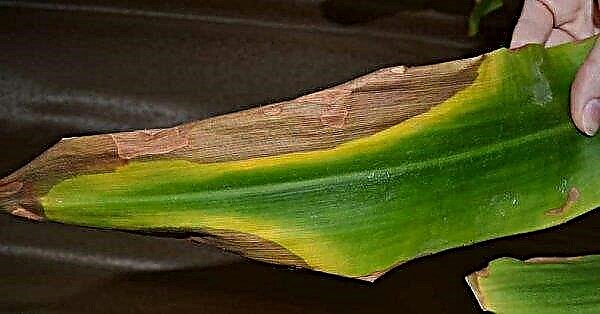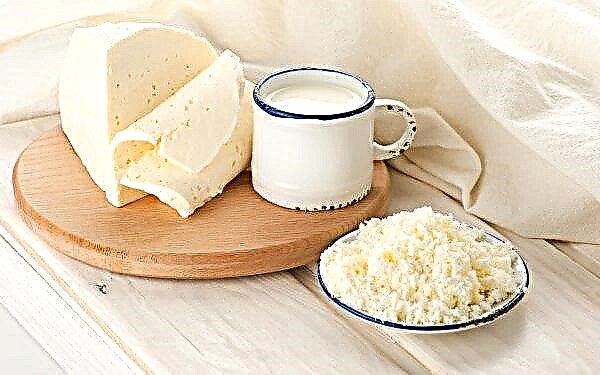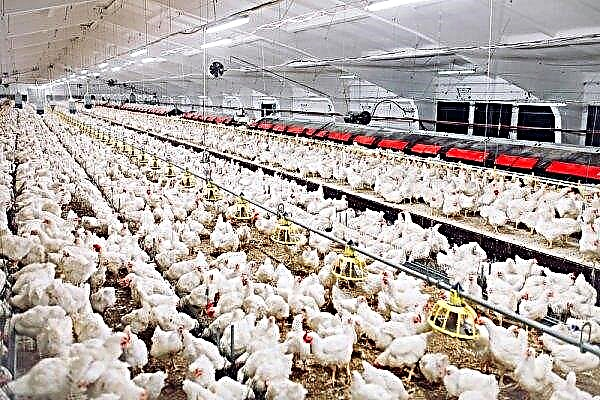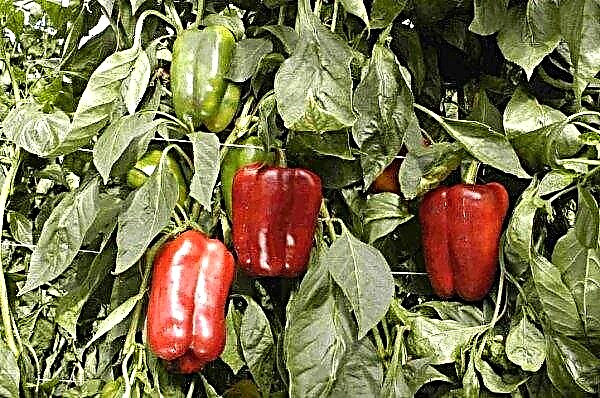The most popular cereal on Earth has been and remains wheat, both spring and winter varieties of it. Winter wheat has a high nutritional value and excellent taste and contains a large number of substances necessary for the full functioning of the human body.
What is winter wheat
Winter wheat is an annual cereal that is sown "under the snow" before the onset of cold weather. Scientists cannot say exactly how many years this culture is, but cereal is widespread in Europe, Asia, North and South America, and even in Africa.

The plant contains substances that can satisfy a person’s daily need:
- B vitamins;
- vitamin PP;
- Vitamin E
- carotene;
- ergosterol;
- proteins;
- fats
- starch.
In industry and agriculture, not only the seeds of this plant, but also secondary waste products, for example, bran and straw, which are used as bedding and animal feed, were widely used. In addition, on the basis of wheat bran, compound feed for birds, cattle and small cattle is prepared, and interior items and environmentally friendly bags, hats and rugs are created from straw.Did you know? Winter wheat has an important agricultural quality - it improves crop rotation, being an excellent precursor for other crops.

The difference between winter wheat and spring
Winter wheat differs from spring wheat in the first place in terms of sowing and harvesting. So, spring varieties are sown in spring, while the timing of sowing winter crops, depending on the region, falls at the end of summer or the first half of autumn.
Did you know? In one of the Swiss museums, an ancient petrified piece of bread is stored, which, according to scientists, was baked 6 thousand years ago.
In addition, winter varieties are characterized by high productivity and a greater susceptibility to disease. If we talk about the quality of grain, then the protein content in winter cereal is higher than in its spring relative.

History of origin and cultivation
It is not known exactly where winter wheat varieties first appeared. The first cultivars of this cereal first appeared in Asia and southeast Turkey, gradually spreading to Europe. Historians claim that wheat, as an agrarian culture, began to grow back in the VIII millennium BC. e. The first varieties were bred from wild wheat - spelled, which grows everywhere.
It is known that in Russia winter wheat was cultivated long before the 1917 revolution. However, it was cultivated only in the southern regions. Currently, with the advent of hybrid varieties that are resistant to frost and drought, as well as to most diseases, the crop is grown both in the south of the country and in the Central zone, and even in the Southern Urals.
Botanical description of the plant
Winter wheat is an annual cereal herbaceous plant that can grow up to 150 cm high. The stem is a hollow straw with thin or thickened walls, depending on the variety. The color of the stem can vary from yellow-white to purple. The leaves of the plant are linear, flat, with a width of 3 to 20 mm. Type of root system of wheat - fibrous.
 I - spelled: 1 - ripened spike. II - soft wheat (spinous): 2 - ripened spike on the side; 3 - an ear on the front side; 4-5 - soft wheat kernel. III - 6 - spike of soft decayless wheat; 7 is a section of a soft wheat kernel. IV - durum wheat: 8 - an ear on the side; 9 - an ear on the front side; 10 and 11 - grain; 12 is a section of a durum wheat grain. V - the structure of soft wheat: 13 - part of the leaf with the tongue and ears; 14 - spikelet with two spikelet scales and with five flowers; 15 - inner floral scales with a pestle, three stamens, two films - lodules, 16 - ovary after fertilization; 17 - spike rod and two spikelets on the side; 18 is the same from the front side.
I - spelled: 1 - ripened spike. II - soft wheat (spinous): 2 - ripened spike on the side; 3 - an ear on the front side; 4-5 - soft wheat kernel. III - 6 - spike of soft decayless wheat; 7 is a section of a soft wheat kernel. IV - durum wheat: 8 - an ear on the side; 9 - an ear on the front side; 10 and 11 - grain; 12 is a section of a durum wheat grain. V - the structure of soft wheat: 13 - part of the leaf with the tongue and ears; 14 - spikelet with two spikelet scales and with five flowers; 15 - inner floral scales with a pestle, three stamens, two films - lodules, 16 - ovary after fertilization; 17 - spike rod and two spikelets on the side; 18 is the same from the front side.
Seeds are collected in inflorescences, which are a complex spike, with spikelets arranged in two rows. The fruit of the plant is a bare or membranous grain with an obvious longitudinal furrow, which is fixed to the ear with the help of flowering scales. The color of the grain varies from white to red.
Winter wheat varieties
Varieties of winter wheat can be divided into two categories:
- Solid. The seeds of such plants contain a small amount of starch, but a lot of gluten, which is why they are widely used in production all kinds of pasta.
- Soft. From grains of soft varieties obtained baking flour of the highest quality of the finest grinding. There is little gluten in it, but a large dose of starch, which makes the product indispensable for the production of confectionery products, as well as all kinds of baking.

To date, a huge number of varieties of winter wheat has been bred, taking into account the characteristics of the growing region:
- Of the soft varieties can be called Nemchinovskaya-57. This culture is grown in the Tula and Moscow regions. It is resistant to heat, frost and lodging of the stem, and also has good immunity to some fungal diseases. The average productivity of Nemchinovskaya-57 is 34 kg / ha.
- Winter wheat cultivar bred for cultivation in the North Caucasus region Don-105. This plant tolerates severe drought, does not lie and does not crumble. In addition, it is quite resistant to frost. The average yield of this variety is 43 kg / ha.
- In addition, the variety is popular in the North Caucasus region. Bezostaya-1. It tolerates heat, mild frosts and has an average resistance to lodging, at the same time, the variety is susceptible to fungal diseases. Productivity Bezostoy-1 is about 40 kg / ha.
- For cultivation in the West Siberian and Ural regions, as well as in the north-west and in the center of the country, the specialists developed a mid-season winter wheat variety Mironovskaya-808. This culture tolerates frosts, is resistant to arid conditions, but can be affected by brown rust. The average cereal yield is 50 c / ha.
- In the same regions you can grow a winter-hardy variety Moskovskaya-39. This wheat tolerates frosts and slight drought.
- In the regions of the Non-Black Earth Region in the Moscow Region and in the middle Volga region, farmers grow winter wheat varieties Galina. This is one of the high-yielding varieties, the average harvest of which can be 70 kg / ha. It has excellent winter hardiness, tolerates drought and is practically not susceptible to disease.
- For farmers of the Kuban and regions of the North Don, breeders have bred a high-yielding winter variety August. It has excellent frost resistance and tolerates late spring frosts. It can yield about 80 kg / ha.
- If we talk about hard varieties of winter wheat, then one of the most popular can be called Agate Donskoy. This variety is recommended for cultivation in the North Caucasus region, as well as the Lower Volga regions of Russia. It is characterized by excellent disease resistance, high drought tolerance, and is also able to tolerate moderate frosts. Productivity of the variety reaches 86 c / ha.
- Durum winter wheat is quite common among farmers. Donchanka. It is recommended for cultivation in the Rostov region and belongs to mid-early varieties. The average yield of Donchanka is not too high and amounts to about 38 kg / ha, but this is offset by good drought tolerance of the crop and resistance to lodging. Among the shortcomings can be called the susceptibility of the variety to cereal diseases.
- Another solid subspecies of winter cereal is Leukurum-21. Experts recommend cultivating the variety in the North Caucasus region. This cereal has excellent yield (about 100 kg / ha), and also has excellent immunity to leaf diseases. It is quite resistant to frost and drought.
Growth Requirements
To get a good harvest of winter wheat, you need to follow the technology of its cultivation. This cereal is very demanding on the composition of the soil and prefers fertile land without weeds. Black soils with a sufficient level of humidity are ideal. If you grow wheat in the Non-Chernozem zone, then gray forest soil, as well as medium loamy and slightly podzolic soils, are suitable for it. In addition, winter wheat does not tolerate wetlands and lowlands.
The seeds of the plant of this culture begin to germinate even at a temperature of + 1 ... + 2 ° C. However, this process is extremely slow, waiting for warming. As soon as the air warms up to + 14 ... + 15 ° С, subject to sufficient moisture, sprouts appear on the surface of the earth within a week.Did you know? The word "abundance" in ancient Russia meant a grain field with a good harvest.

The culture does not tolerate the difference between day and night temperatures, especially in autumn and early spring, as well as severe frosts without snow. In spring, the plant begins to cluster when the air temperature reaches + 9 ... + 10 ° C. When cooling, tillering stops. Wheat is also poorly bush with severe drought.
Important! Cereal is very demanding on soil moisture, and the highest yield can be expected in regions where this figure is 70–75%.
Productivity
Productivity of winter culture directly depends on the conditions of its cultivation. So, in fertile chernozems with a rather mild climate, you can count on record fees. In the case of natural anomalies, for example, when the air temperature drops below –18 ° C, and there is no snow cover, wheat may die completely.

The same applies to summer drought, when the temperature rises above + 38 ° C and the soil dries up. In this case, the crop may also die. In this case, high-quality watering will help to save the situation, and timely application of fertilizers will help to increase the fertile soil quality.
Stages of development
Winter wheat develops in several stages, each of which directly affects the quality of the crop:
- The stage of emergence of seedlings. This period lasts from the appearance of the first sprouts to the snowfall. Under snow, wheat falls into a kind of hibernation and practically does not grow. In case the cereal has gone under the snow with two or three first leaves, the seedling phase will continue in the spring, after the snow melts.
- Stage of tillering. The culture begins to heap with the arrival of the first spring heat.
- Step in the handset. This is the name of the process of appearance on the main stem of the first node. Usually this period begins a month later from the beginning of spring vegetation.
- Heading stage. Immediately the appearance of spikelets on the shoots of the plant.
- Flowering stage. 4-6 days after the appearance of young spikelets, they bloom. This process lasts about 7 days, spreading from the bottom of the spikelet up.
- Ripening stage. After the seeds are formed, they begin to gradually lose moisture. After 2 weeks, the grains reach milk maturity, after it comes the wax phase, and then the time for full ripeness, when the wheat becomes hard and the amount of moisture contained in it does not exceed 20%.

Sowing technology
One of the most important factors directly affecting germination, winter hardiness, growth and productivity of a crop is proper sowing. It is important to take into account the forecasts of meteorologists for the season, the periods of cooling and snowfall, the amount of precipitation, etc. This is necessary in order to calculate the sowing dates, because the cereal must have time to ascend and dissolve several leaves, and at the same time it must not be allowed to outgrow. Among other things, you need to properly prepare the soil for sowing, fertilize and treat pests.
Sowing dates and seeding rates
Sowing dates are determined by the climatic conditions of the region. The optimum temperature for planting winter crops is considered the time when the average daily temperature is + 14 ... + 15 ° C. Ideally, the total period of autumn vegetation should be from 40 to 50 days. So, in the southern regions, winter wheat is sown in the second half of September, while in central Russia this time is shifted to the very beginning of autumn. Closer to the north, the sowing period falls in the second half of August.
In addition, choosing the time for sowing, one should take into account the composition and fertility of the soil. On poor soils, sowing should be done earlier, and on chernozems - later so that the plants do not outgrow by the wintering period.
Sowing rates largely depend on the content of nutrients in the soil. The characteristics of the variety should also be taken into account, since when planting low-bushy species, the norm should be increased. On fertile lands, the number of grains per hectare must be reduced, because the beneficial substances contained in the soil will stimulate the active growth of plants. On the depleted lands, on the contrary, thicken the plantings in order to prevent the weeds from sprouting, which are poorly tolerated by the wheat.Important! The average seeding rate is 140–200 kg of grain per 1 ha. But there were cases when the yield record was broken by crops planted at the rate of 80–100 kg per 1 ha.

Ways
There are several ways to sow winter wheat. The most popular of them are called narrow-row and cross methods. Plants sown by these methods are evenly placed on the field and develop the root system, and are also characterized by increased bushiness.
In addition, they are characterized by excellent frost resistance and high productivity. This is due to the fact that crops planted by narrow-row and cross-sectional methods very quickly close, leaving no chance for weeds to germinate, and also preventing the evaporation of moisture from the soil.
 a- ordinary; b-band; in-scatter; g - narrow row; d - cross; e - wide-row and dotted; yellow tape; h - nesting; and - square-nested; to - combined; l - sowing in the comb; m - sowing in the garden; n- sowing in furrows; o- sowing in stubble
a- ordinary; b-band; in-scatter; g - narrow row; d - cross; e - wide-row and dotted; yellow tape; h - nesting; and - square-nested; to - combined; l - sowing in the comb; m - sowing in the garden; n- sowing in furrows; o- sowing in stubble
Depth
If earlier the depth of sowing winter crops was 5-10 cm, then in recent years, experts have given slightly different recommendations. They are associated with the cultivation of new varieties that are more adapted to climatic conditions. Currently, farmers sow winter wheat no deeper than 2-3 cm. This gives good germination and heaping of seeds, and also provides good bushiness.
Important! In the event that the first signs of lodging appear, the field is sprayed with retardants to slow the growth of the culture and strengthen the stem tissue.
Care
Winter wheat care starts from the moment the field is prepared for sowing. Depending on the degree of soil moisture, immediately after sowing, harrowing or rolling the soil with ring-spur rollers is carried out. Before emergence, they do not allow the crust and small weeds to appear on the soil. For this, light harrows and hoes are used. Among other things, winter crops require periodic top dressing with minerals and organics.
In case of emergence of seedlings of signs of disease or parasites, spraying with appropriate drugs is carried out. In addition, preventive measures are taken to control rodents by introducing ammonia water into mouse burrows or placing baits.
In the spring, after the snow melted, the fields of winter wheat were again harrowed to remove weed grass and dead seedlings. Too thickened areas are also harrowed. If a lot of weeds appeared on the field, then herbicides are used to combat them. In addition, do not forget about pests, at the first signs of which insecticides should be used.
Watering and fertilizer
The growth and productivity of cereals largely depends on the composition of the soil and the presence of nutrients in it. During the entire growing season, wheat needs both mineral and organic fertilizers.Before sowing, ammonium nitrate must be introduced into the soil based on the norm of 30 kg / ha. Next time, the plant will need nitrogen when the tillering phase begins. Then the norm is 35–40 kg / ha. During tube formation, the following nitrogen dose is applied: 60–75 kg / ha.
No less than nitrogen, phosphorus is needed in winter. Phosphorus-based fertilizer is applied at the stage of tube formation before flowering begins. This top dressing provides early fruiting, protection against premature aging and excellent grain quality. Wheat also needs potassium. The best periods for applying potash fertilizers are the phases of germination and the beginning of the formation of the tube. To do this, solid fertilizing is scattered at the stage of preparation of the field for sowing.Important! Nitrogen fertilizers are applied only by the root method to the additionally moistened soil. Otherwise, ingestion of crystals of fertilizing on the leaves of plants can cause severe burns.
When growing crops on acidified soils, additional calcium nutrition is needed to reduce acidity. In addition, calcium increases the resistance of plants to diseases and adverse environmental conditions.
Magnesium provides the process of complete photosynthesis, which affects the general condition of wheat, and sulfur is responsible for protein metabolism, which positively affects the growth of the culture. In addition to minerals, culture simply needs organic matter. For this, farmers widely use chicken manure, manure, and humus. They are introduced into the soil when plowing at the rate of 25-30 t / ha.
Winter wheat is distinguished by its exactingness to the amount of moisture in the soil. So, before sowing, it is necessary to ensure the norm of soil spillage in the amount of 1000 m³ / ha, taking into account precipitation. Such an amount of moisture will ensure a good development of the root system, as well as a full spring vegetation. The so-called water-charging irrigation is carried out before plowing the field about a week before sowing.
With the onset of spring, vegetative irrigation begins based on a calculation of a moisture level of 70–80%. This indicator is especially important during the period when the plant enters the tube, the formation of an ear and the direct pouring of grain. The norm of vegetation irrigation is 600–800 m³ / ha.
Fight against diseases, pests and weeds
When choosing the right method of sowing winter wheat and sowing norms, the question of weeds, as a rule, disappears by itself, since the roots of the plant quickly grow together, forming a dense barrier. If plantings are sparse, weed grass breaks through them and grows very quickly, depleting the soil. In this case, to control weeds, special herbicides are used that have a detrimental effect on the root system of weeds through the leaves.
With diseases and pests, the situation is much more complicated. The greatest harm to wheat is caused by all kinds of rust, such as yellow, brown and stem, as well as hard and dusty smut, snow mold, root rot. To combat fungal leaf diseases, a solution of colloidal sulfur is used at the rate of 10 kg of sulfur diluted in 100 l of water per 1 ha of crops.
In addition to diseases, winter wheat crops are also affected by pests such as bug-bug, ground beetle, wireworm. Supporters of organic farming use biological methods to control pests, for example, they use egg-eaters that can destroy parasites.
For quick destruction, you can use chemicals, for example, pollination of crops with a 12% solution of hexachloran dust. The same preparation is used to treat seeds immediately before sowing, based on the calculation of 10 kg per 1 ton of grain.
Harvest
There are two ways to harvest winter crops:
- direct combining;
- separate two-phase method.
The first method is used if the grain is fully ripe, and weather conditions do not interfere with the collection. This method allows you to minimize costs and, accordingly, reduce the cost of harvesting. At the same time, wheat retains its food and sowing qualities, and grain losses are minimal.
In practice, the second, separate method, which consists of two stages, is most often used. In this case, the harvest occurs at the stage of wax ripening of grain. In the first phase, the crop is mowed into rolls, and after 5-7 days harvested by combines. At the same time, grain losses are 5% more than with the single-phase method, but this method makes it possible for seeds to ripen unevenly to reach full maturity.
After threshing, the crop is transported to the elevator. There, with the help of dryers and cleaning units, post-harvest processing of cereals is carried out, cleaning the crop of weeds and insects. There grains are calibrated and dried.
Storage rules
For storage of winter wheat, dry, well-ventilated rooms with an air temperature in the range of +5 ... + 8 ° C are used. The humidity in the room must comply with the norm of 65–70%.
It seems to a simple layman that growing winter wheat on the field is simple and does not require much effort. However, this is not so easy, because culture requires constant care and attention in order to get a high yield of high-quality grain.Important! Before sending the crop for storage, the premises must be subjected to mandatory disinfection. Wheat should be mixed periodically so that the grain does not rot or overheat.

